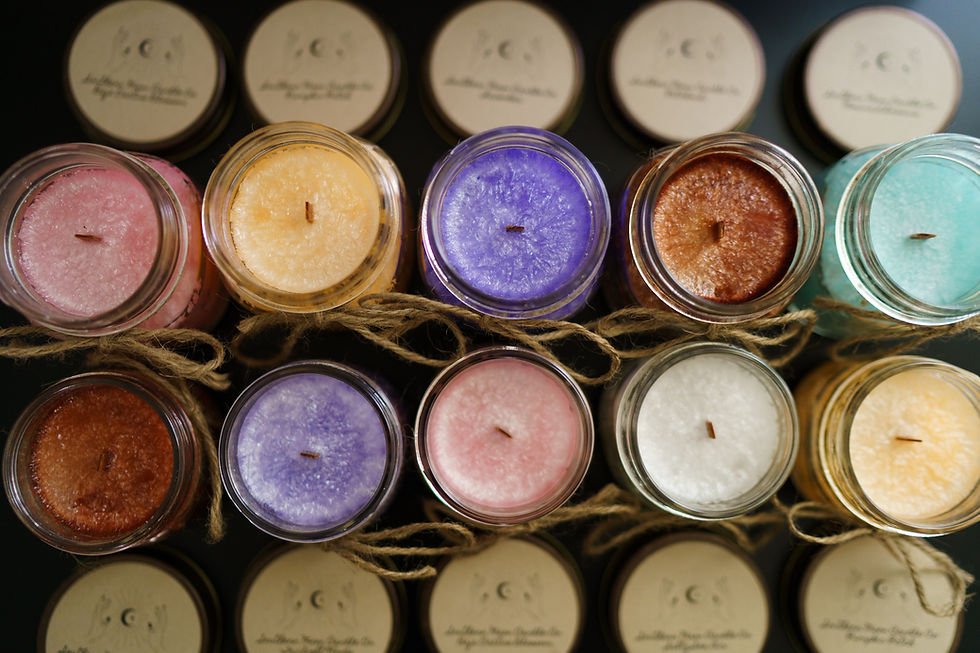A Beginner's Guide to Coloring Candles Safely with Dyes or Natural Alternatives
- pamela Bloem
- Jul 9, 2024
- 3 min read
Updated: Jul 10, 2024
Welcome, candle-making enthusiasts, to this step-by-step guide on how to bring vibrant colors to your homemade candles safely and effectively! Whether you are just starting your candle-making journey or looking to enhance your skills, this guide will walk you through the process of coloring candles using dyes or natural alternatives.
Materials You'll Need:
Before diving into the colorful world of candle making, make sure you have the following supplies on hand:
Candle Wax
Candle Wicks
Candle Making Kit
Candle Dyes or Natural Colorants
Double Boiler
Stirring Utensil
Measuring Spoons
Containers for Candle Making

Using Candle Dyes:
When it comes to coloring your candles, candle dyes are a popular choice due to their vivid hues and ease of use. Follow these simple steps to incorporate candle dyes into your candle-making process:
Prepare Your Workspace : Set up your candle-making station in a well-ventilated area and ensure all your materials are easily accessible.
Melt the Wax : Using a double boiler, melt the candle wax following the instructions provided in your candle making kit. Remember to maintain a safe temperature to prevent the wax from overheating.
Add the Dye : Once the wax is fully melted, it's time to add the candle dye. Start with a small amount and gradually increase until you achieve the desired color intensity. Stir the dye into the wax thoroughly for even distribution.
Test the Color : To preview the final color of your candle, dip a white piece of paper into the colored wax. This simple test will give you a good idea of how the candle will look once it solidifies.

Pour and Set : Place the wick in your chosen container and carefully pour the colored wax into it. Allow the candle to cool and set for the recommended time before trimming the wick.
Enjoy Your Colorful Creation : Once the candle has fully set, light it up and bask in the warm glow of your beautifully colored creation!
Natural Alternatives:
For those looking to add color to their candles using natural ingredients, fear not! Nature provides an array of options to create unique and eco-friendly candles. Here are some natural colorants you can experiment with:
Beetroot Powder : Produces shades of pink and red.
Turmeric : Adds a vibrant yellow color.
Spirulina Powder : Creates hues of green and blue.
Cinnamon : Infuses a warm brown tone.
Paprika : Provides an earthy red hue.

Experiment with these natural colorants by infusing them into your melted wax and adjusting the quantities to achieve your desired colors. Not only do natural colorants add a unique touch to your candles, but they also serve as a sustainable and non-toxic alternative to traditional dyes.
Conclusion:
Coloring candles is not only a creative endeavor but also a therapeutic one. Whether you opt for the bold hues of candle dyes or the natural charm of botanical colorants, the process of adding color to your candles will undoubtedly elevate your candle-making experience. So, gather your supplies, unleash your creativity, and let the colors illuminate your candlelit moments!
Now that you have the tools and knowledge to color your candles, it's time to get started on your colorful candle-making journey. Happy crafting!
Remember, the beauty of candle making lies not only in the final product but also in the joy of creating something truly unique with your own hands.
So, embrace the colors, ignite your creativity, and let your candles shine bright!









Comments